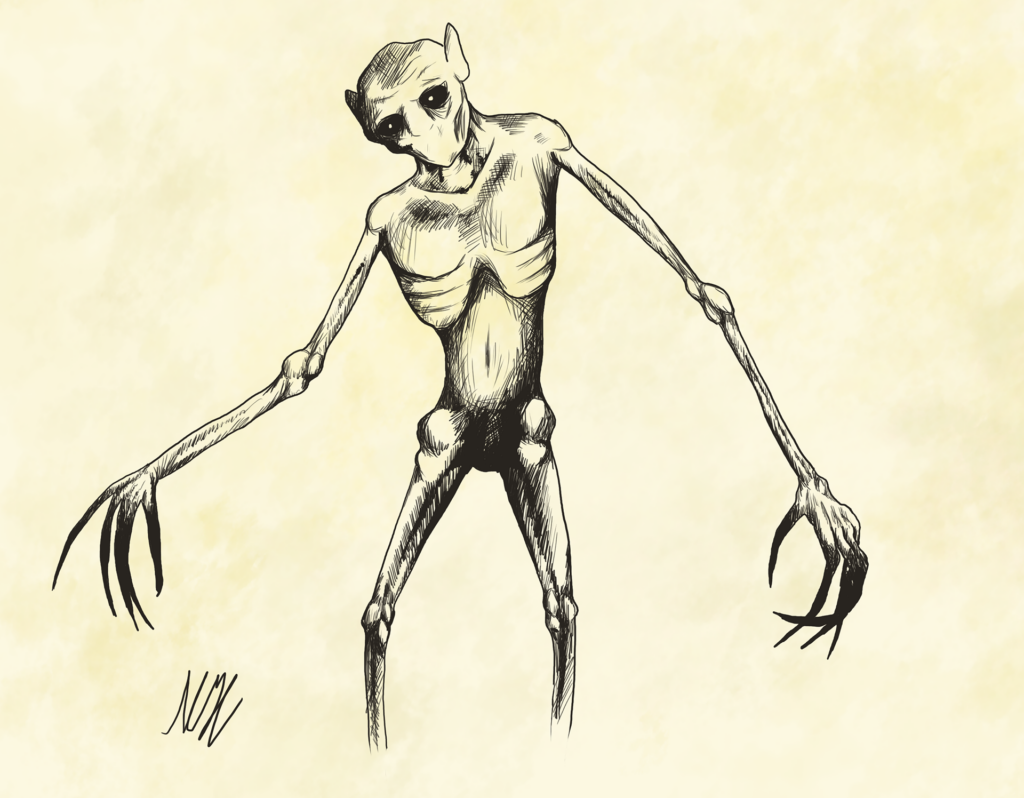Na Losa Falaya
Nalusa Falaya is a figure from Choctaw mythology, a Native American tribe from the southeastern United States. Often described as a shadowy, malevolent creature, Nalusa Falaya is one of the more frightening beings in Choctaw folklore, serving as both a trickster and a terror that haunts the wilderness.


Description and Appearance
- Physical Traits:
- Nalusa Falaya is typically depicted as a tall, thin figure with long limbs and a dark, shadowy complexion, giving it an eerie and otherworldly appearance. Its most distinctive feature is its extremely long, snake-like body that allows it to move stealthily through the forests.
- It is said to have a human-like face, but with elongated features and sometimes glowing red eyes that add to its frightening appearance. In some versions, it is described as having sharp teeth and claws.
- Nalusa Falaya is often seen lurking or crouching close to the ground, further emphasizing its connection to the earth and shadowy realms.
- Creeping Gait:
- One of the more disturbing aspects of Nalusa Falaya is the way it moves. It is said to slither or crawl close to the ground, much like a snake. This movement allows it to approach its victims silently before striking.
Role in Choctaw Mythology
- Bringer of Fear and Evil:
- Nalusa Falaya is often seen as a bringer of evil or a creature that embodies darkness and fear. It preys on the minds of those who encounter it, often causing great terror. It is known to hide in dark places, particularly in forests, waiting for the right moment to attack or frighten those who wander too close.
- Manipulator and Trickster:
- In some stories, Nalusa Falaya is portrayed as a trickster. It may play tricks on people by mimicking human voices or luring them into the forest, only to terrify or harm them once they are far from safety. This trickster aspect of its personality adds to its role as a figure of terror.
- It is believed that Nalusa Falaya can control the minds of its victims, causing them to become confused, disoriented, or paralyzed with fear.
- Feeding on Fear:
- In many Choctaw legends, Nalusa Falaya is said to feed on fear. It thrives on the terror it instills in those it encounters, and its power grows the more fear it can create. This makes it a particularly dangerous entity for those who are easily frightened.
Symbolism
- Fear of the Unknown:
- Nalusa Falaya represents the fear of the unknown and the dangers that lurk in the wild, unexplored parts of the world. For the Choctaw people, who lived in close proximity to forests and natural landscapes, the creature embodies the mysterious and sometimes hostile forces of nature that could be encountered in the wilderness.
- Darkness and Shadow:
- The shadowy form of Nalusa Falaya is symbolic of the power of darkness and the unknown. The creature’s ability to hide in the dark, coupled with its stealthy movements, represents the fear that many have of what cannot be seen or understood.
- It also serves as a reminder to respect the natural world and to be cautious when entering dark, unfamiliar places.
- Trickster and Balance:
- While Nalusa Falaya is a terrifying figure, its trickster nature also reflects the balance in Choctaw mythology between good and evil forces. In many Native American traditions, tricksters are seen as necessary figures who disrupt the balance to teach lessons or reinforce the importance of caution, wisdom, and bravery.
Nalusa Falaya in Modern Culture
- Regional Folklore:
- Nalusa Falaya remains an important figure in Choctaw culture and is still mentioned in stories told to children and community members. It serves as a cautionary tale, warning people to stay out of the woods at night and to be aware of their surroundings.
- Influence on Popular Media:
- While Nalusa Falaya is not as widely known as other mythological creatures, its eerie characteristics have inspired depictions of shadowy, lurking monsters in some works of fiction, particularly in the horror genre. Its connection to darkness, trickery, and fear aligns it with other malevolent beings in folklore worldwide.
Conclusion
Nalusa Falaya is a chilling and mysterious figure in Choctaw mythology, embodying fear, darkness, and trickery. As a shadowy creature that preys on the minds of those it encounters, Nalusa Falaya represents the dangers of the unknown and the power of fear itself. Its role as both a trickster and a predator serves as a reminder of the respect that must be given to the natural world and the unseen forces that inhabit it.
Description

The Nalusa Falaya is a creature from Choctaw mythology. Its name is literally translated to “long black being” and it is usually described as a tall skinny humanoid with long ears. It has however been described as slithering like a snake and/or melting into a shadow [1].
The Nalusa Falaya lingers in the long shadows in the dusk and frightens children who stay out too late as well as the occasional careless hunters [1].
It is described as planting thorns into a hunter’s hands and feet giving them the power to do evil to others. The hunters remain ignorant of this until their malevolent actions reveal it [1]. Similar to witch myths from Europe and colonized America these people were too afraid to tell others of their power so as to not be prosecuted. [2]
The children of the Nalusa Falaya have the ability to remove their internal organs and appear as small bodies of light seen along the edges of marshes similar to the will-o’-wisps [3].
Sources:
[1]: Lankford, George (1987). Native American Legends : Southeastern Legends–Tales from the Natchez, Caddo, Biloxi, Chickasaw, and Other Nations. Little Rock: August House.
[2]: Kidwell, Clara Sue. Choctaws and missionaries in Mississippi, 1818-1918. University of Oklahoma Press, 1997.
[3]: Ajk’in. “What do you know about nalusa falaya?” scriptmyth, scriptmyth.tumblr, (2018-08-04), https://scriptmyth.tumblr.com/post/176629514492/what-do-you-know-about-nalusa-falaya. (2022-11-03).
Author

Josh Morley holds a Bachelor’s degree in Theology from the Trinity School of Theology and a Diploma in Theology from the Bible College of Wales. His academic journey involved interfaith community projects and supporting international students, experiences that shaped his leadership and reflective skills. Now based in Liverpool, Josh is also the founder of Marketing the Change, a digital agency specializing in web design and marketing.
View all posts




